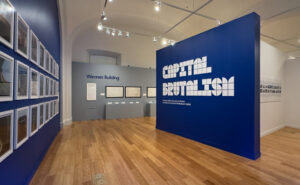Two new exhibits at the National Building Museum explore architecture that is and could have been. But one in particular, Capital Brutalism, answers the question we hear so often around DC — But why does it have to look like that??!

Capital Brutalism will be on display at the museum through February 17, 2025.
This exhibition focuses on seven high-profile public buildings in the nation’s capital that have, controversially, been called ‘imposing monsters.’

In the 1960s and 1970s, Brutalist architecture flourished in DC, as a cost-effective solution for public construction projects amid federal urban renewal initiatives. Despite that initial support, today’s Brutalist buildings aren’t generally well-liked. (The FBI Building was labeled as one of the “ugliest” in the world!)
Given the time that has passed, DC now faces a decision on whether to renovate or demolish its Brutalist buildings. Capital Brutalism uses archival documents, drawings, architectural models and contemporary photographs, to explore these buildings and possibly even reimagine them.

Just across the National Building Museum’s Great Hall, both realized and unrealized projects from famed architect Frank Lloyd Wright are on display in Frank Lloyd Wright’s Southwestern Pennsylvania, which will will be on view through March 17, 2025.
This exhibition which takes visitors on a journey into the famed architect’s mind, including a multimedia experience that brings Wright’s unrealized design ideas to life for the first time.
“By presenting both realized and unrealized projects, the exhibition encourages visitors to consider ‘what might have been,’” said Fuchs, suggesting that Wright’s work architectural work in the region from the 1930s through the 1950s — both what was built and what wasn’t — might have impacted urban, suburban, and rural landscapes.

![[Vid] A Preview of Hillwood’s New “Fragile Beauty” Exhibition with the Curator](http://kstreetmagazine.com/wp-content/uploads/2024/06/Screenshot-2024-06-04-at-2.36.44 PM-176x133.jpg)


